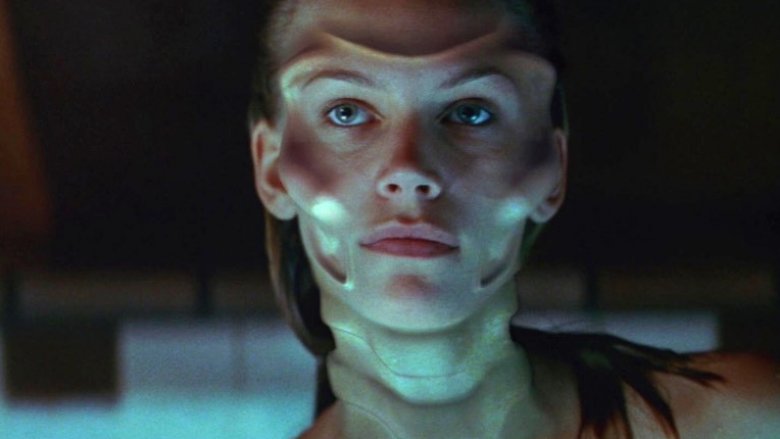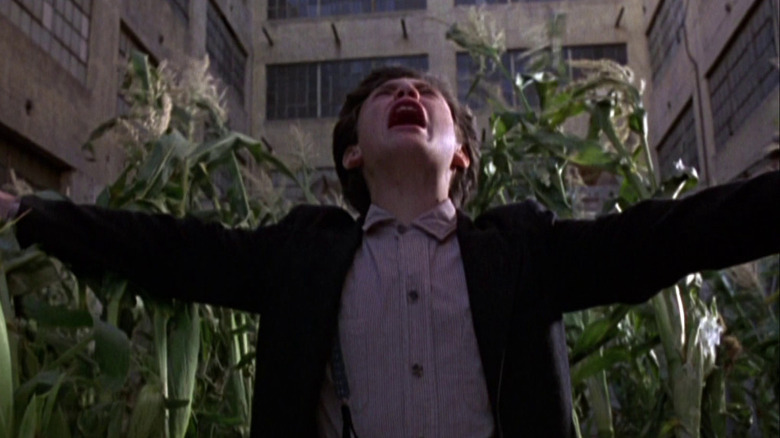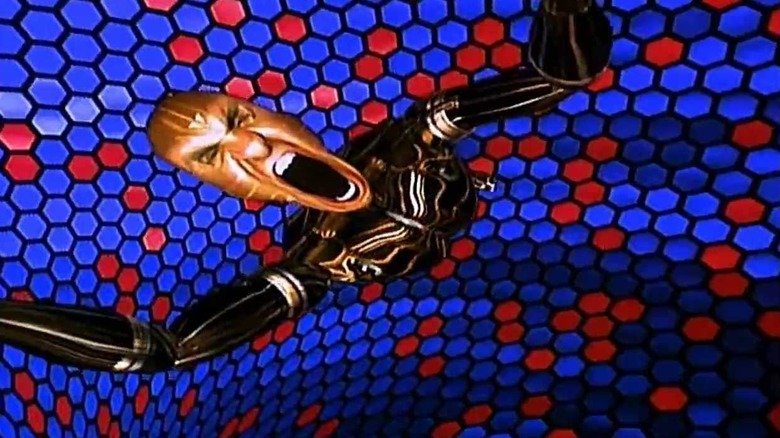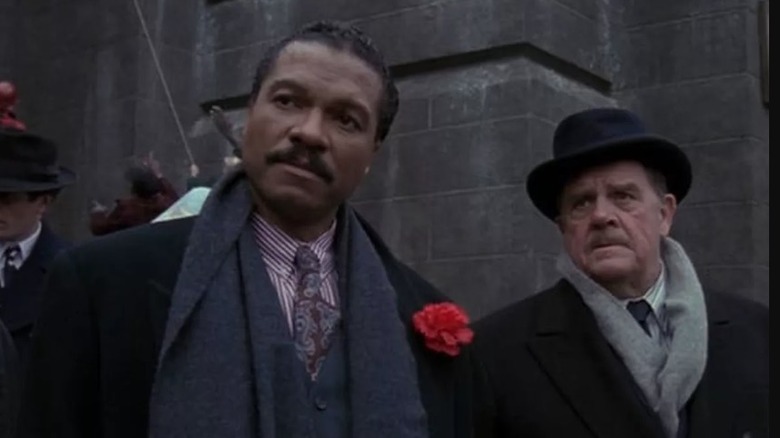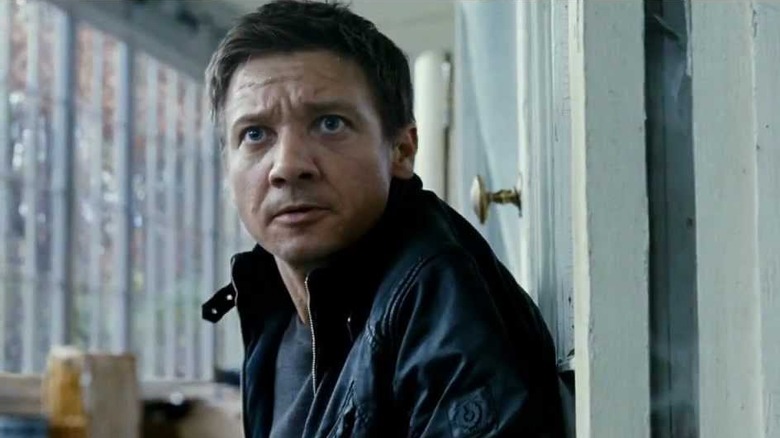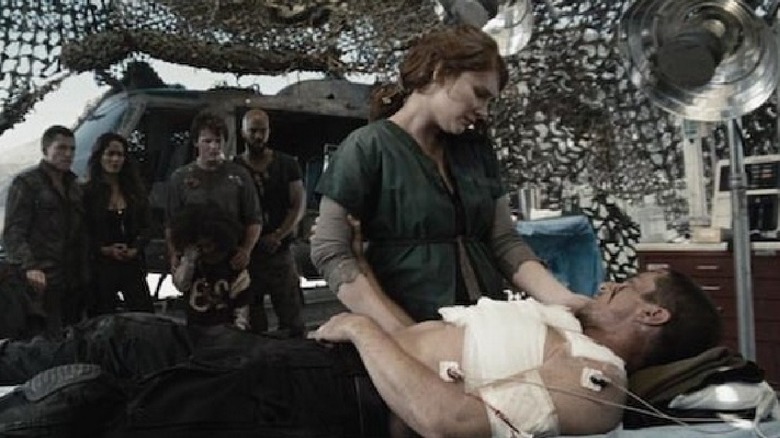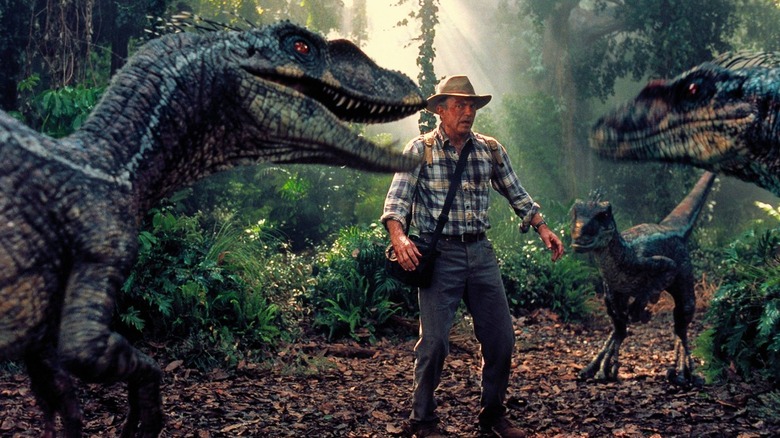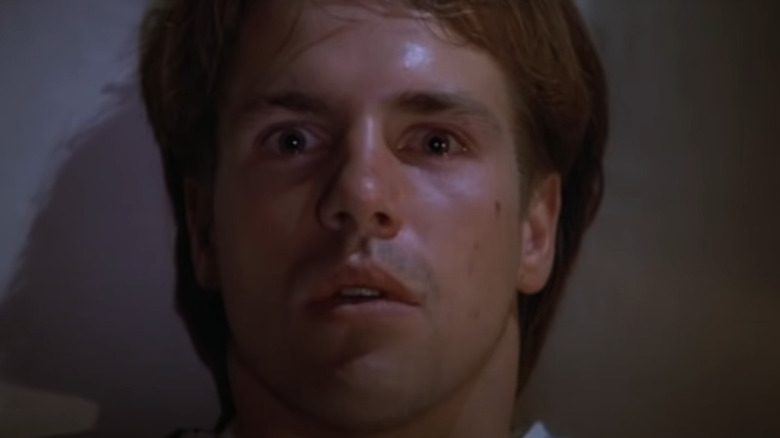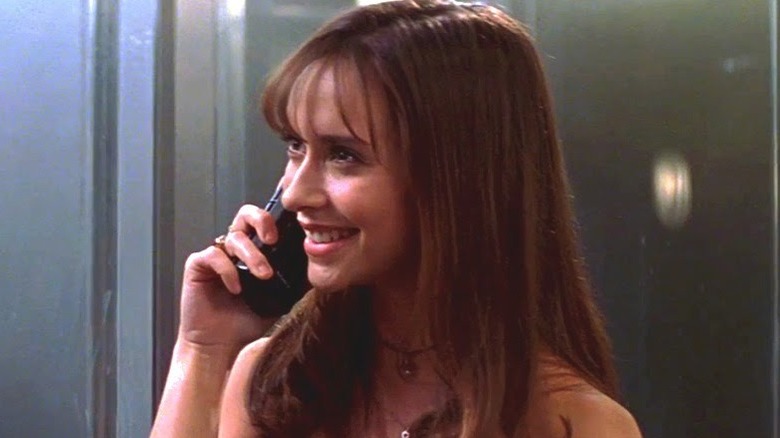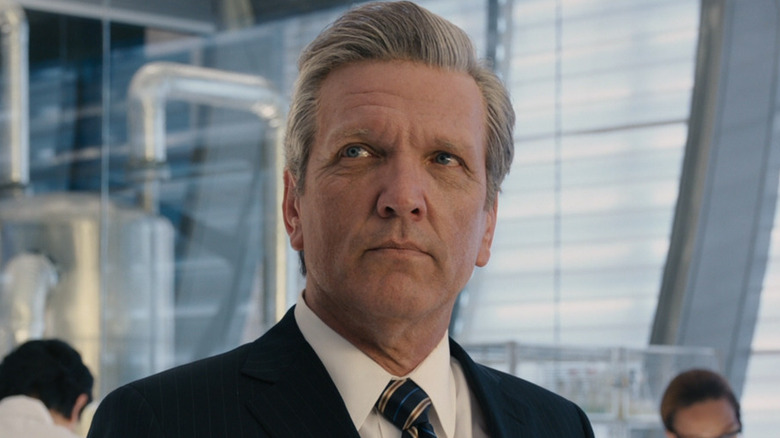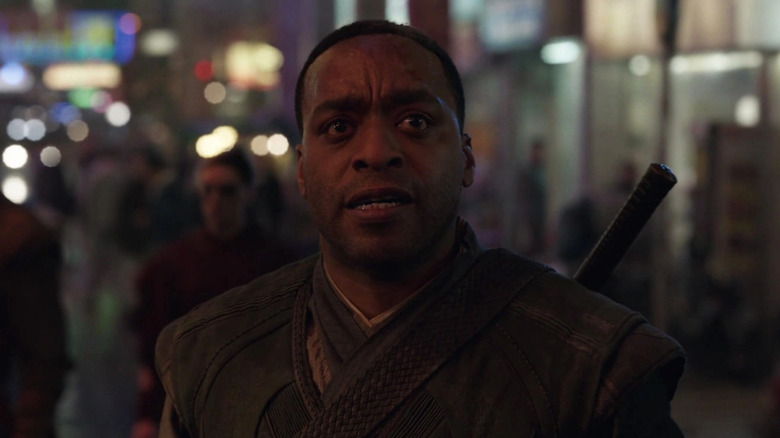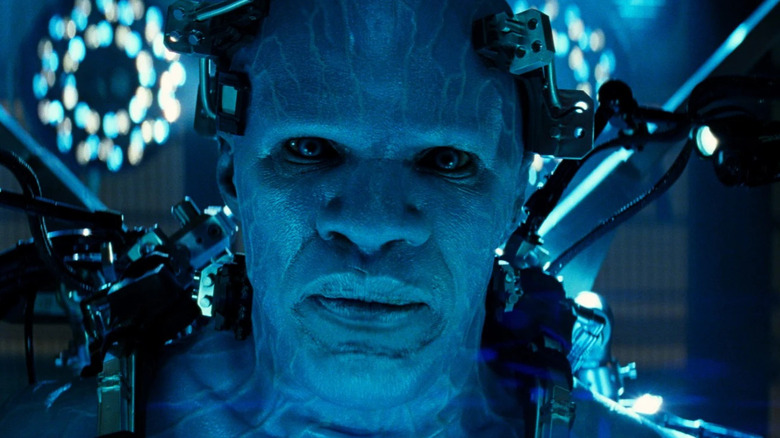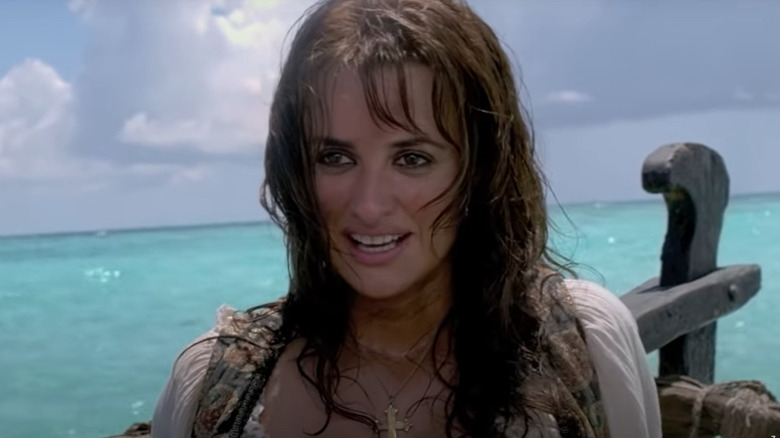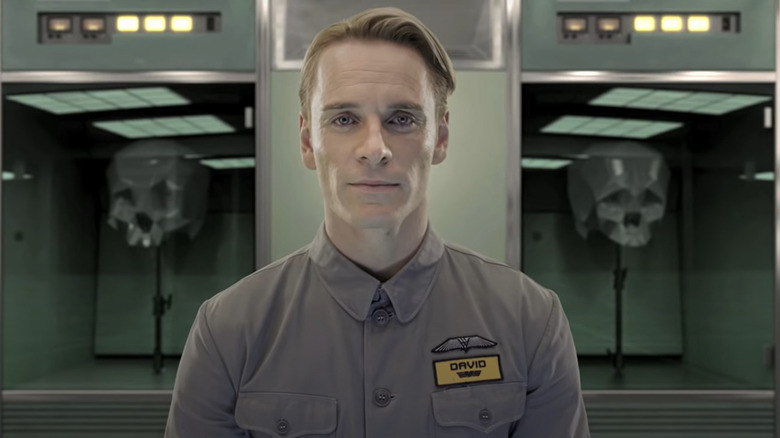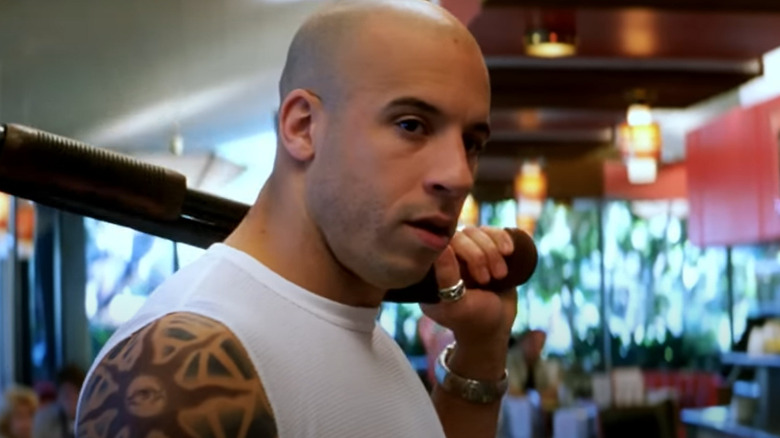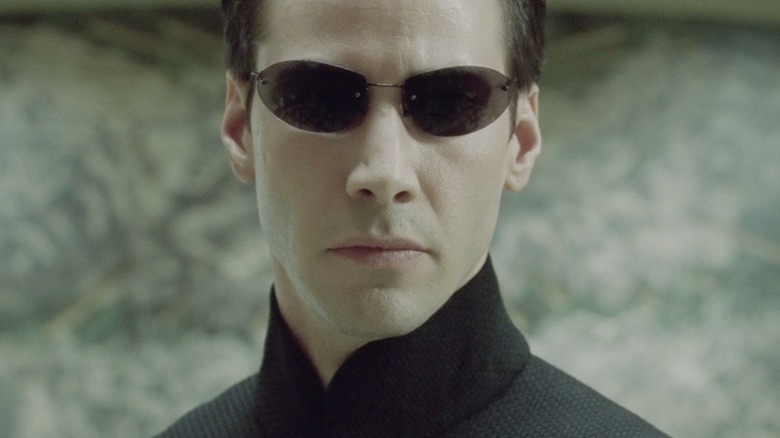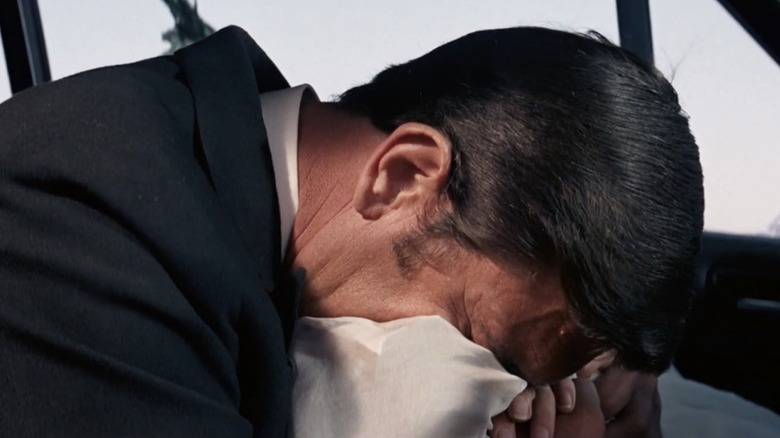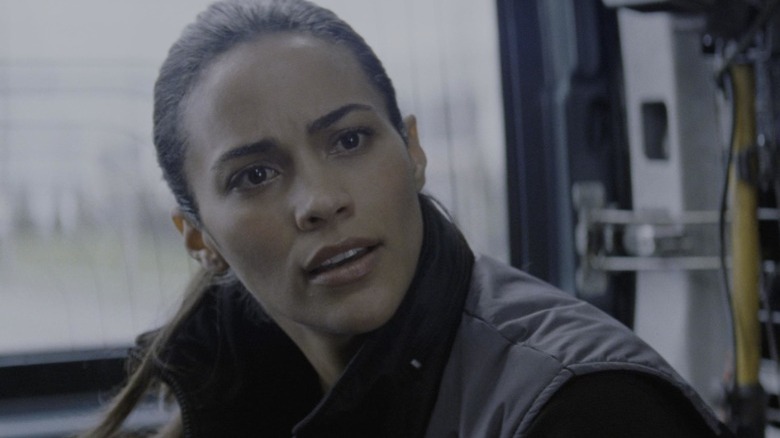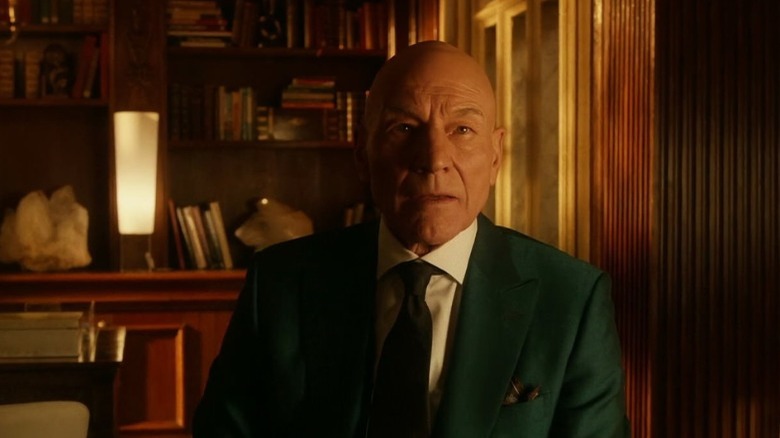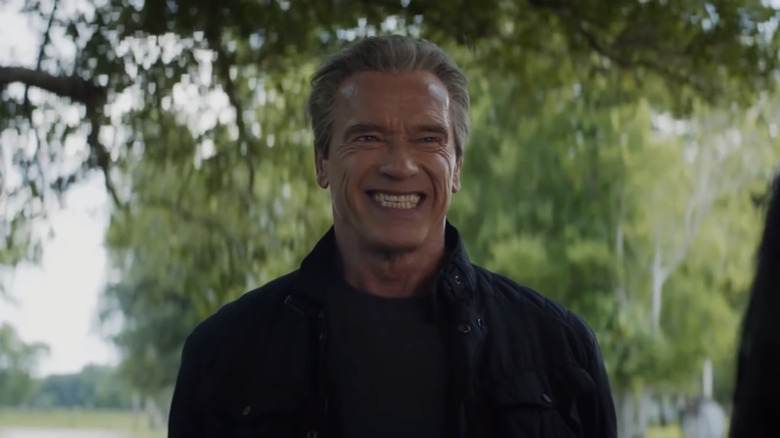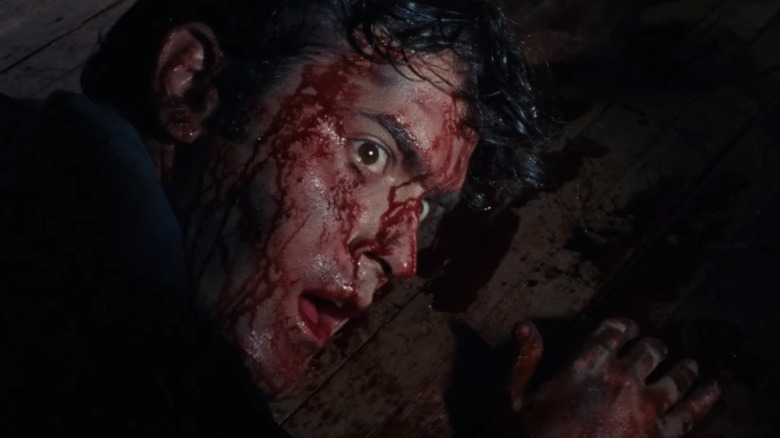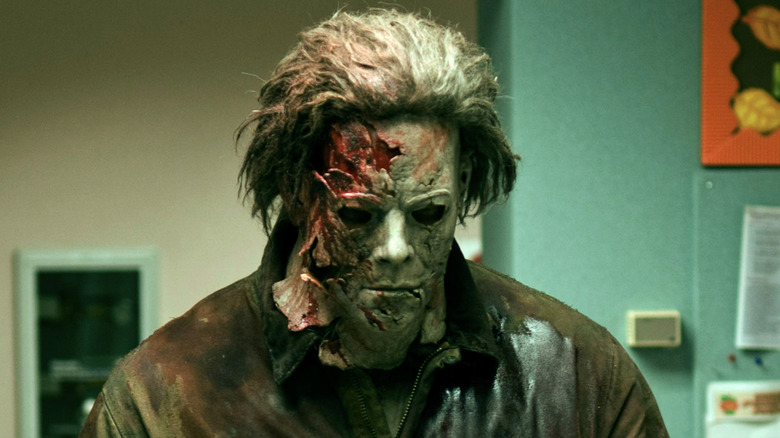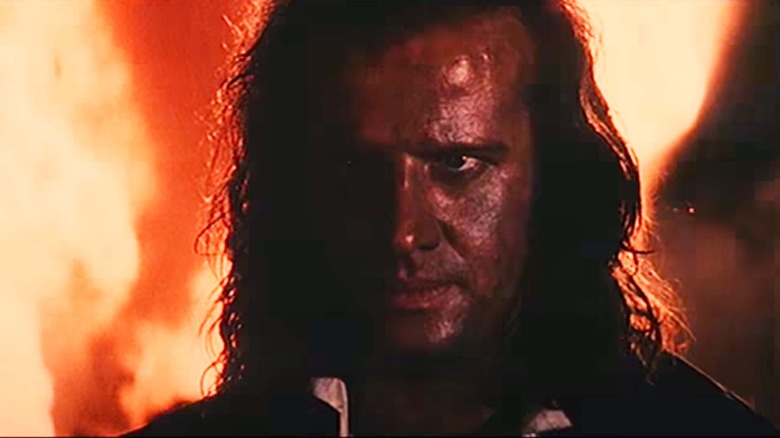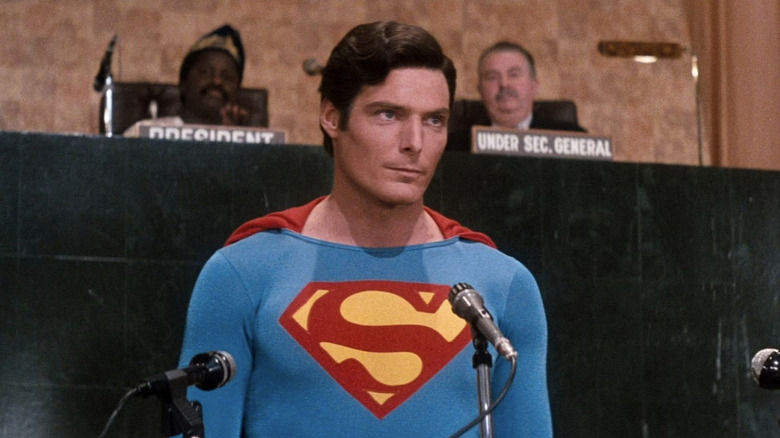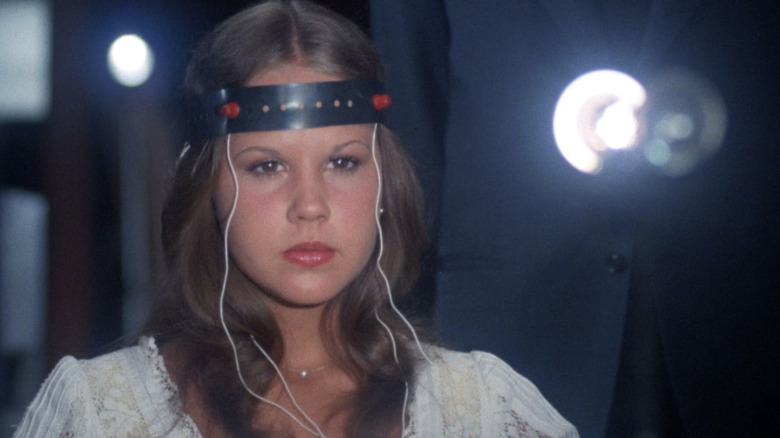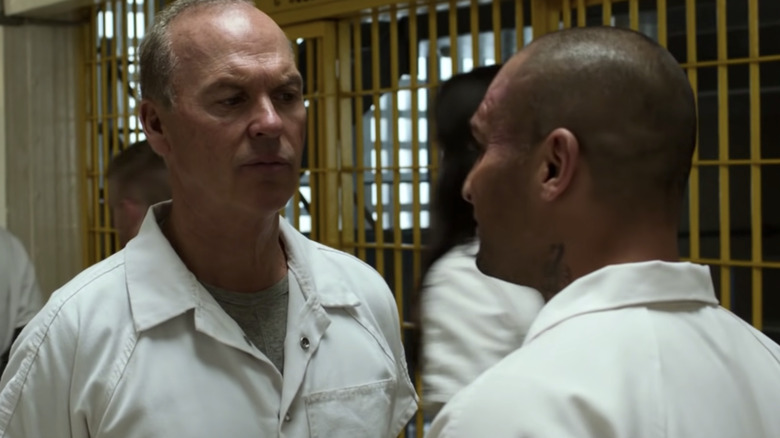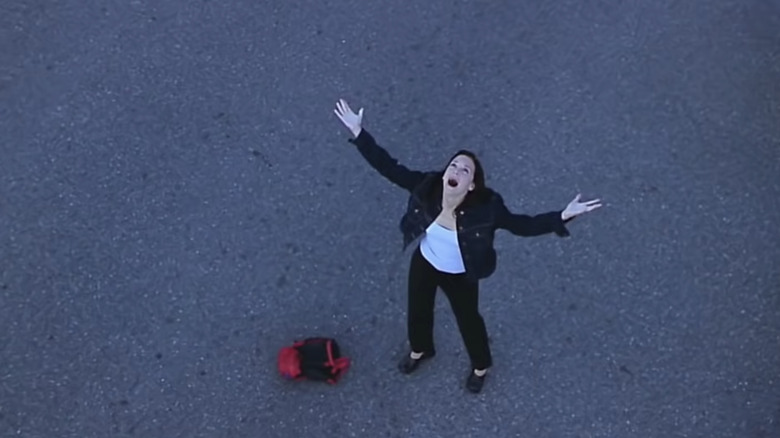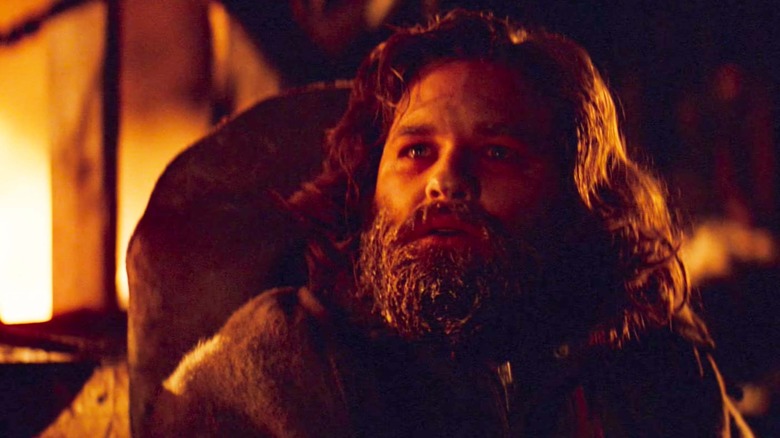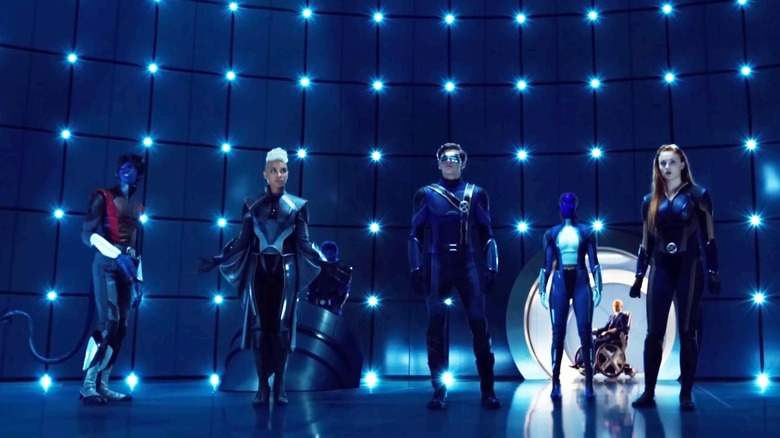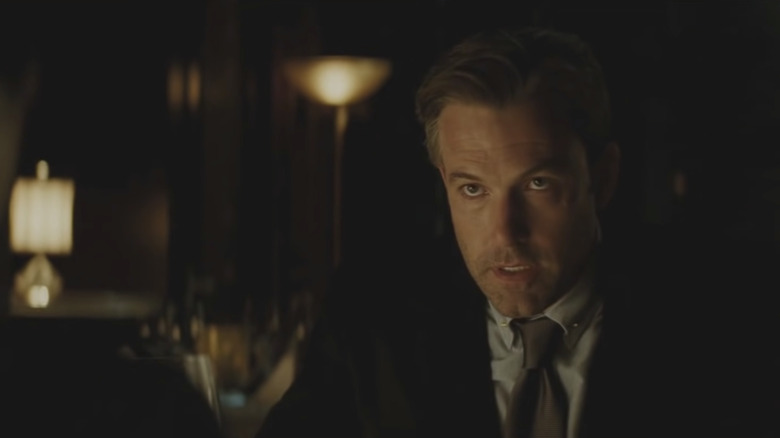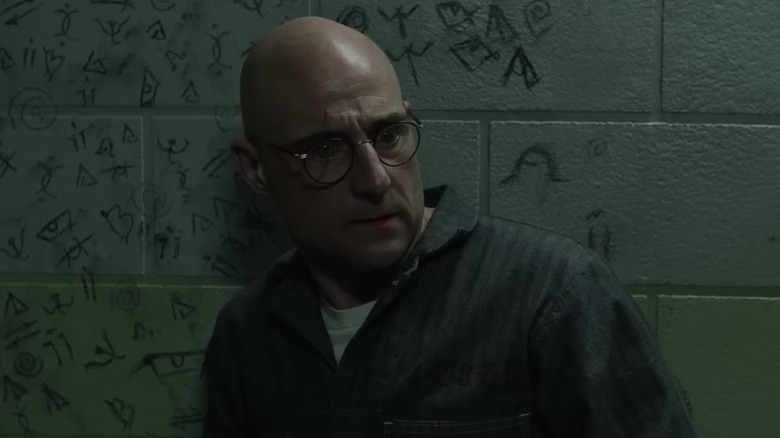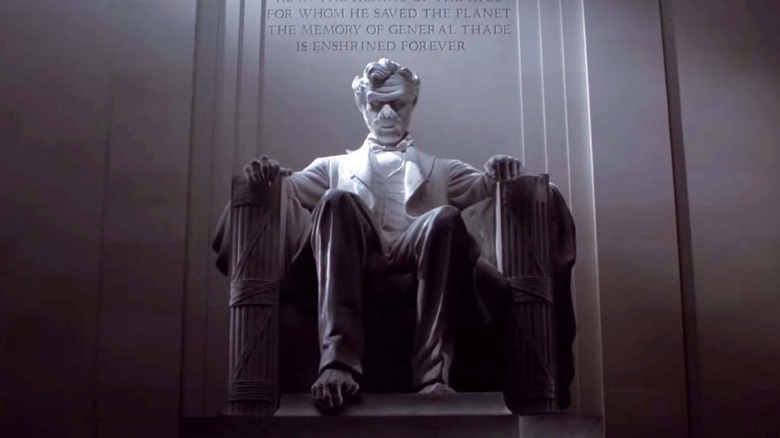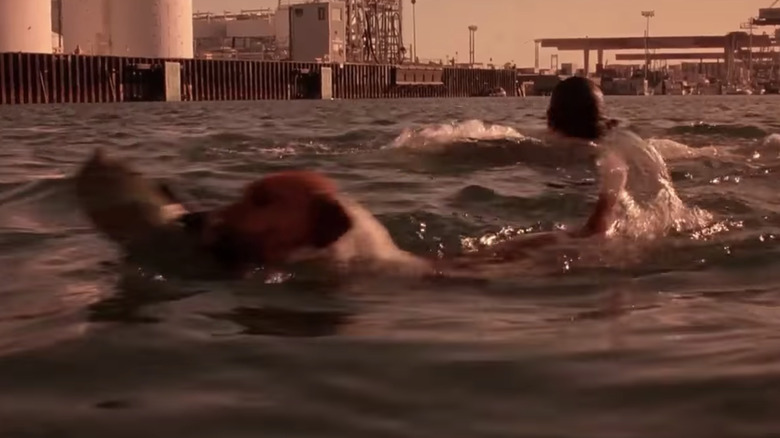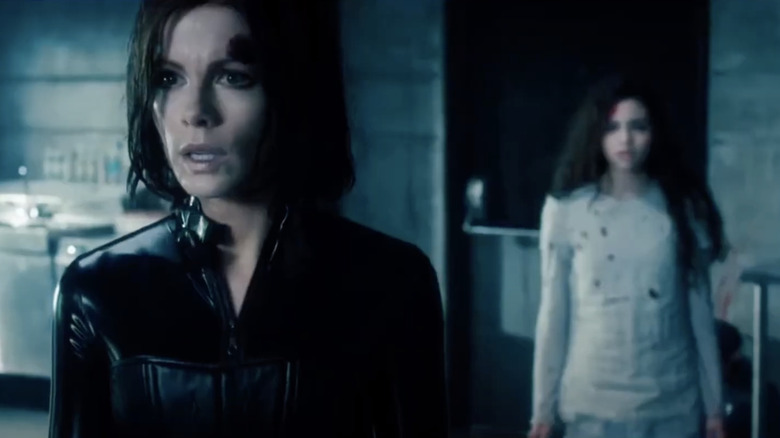Cliffhangers That Sequels Totally Ignored
These days, it's almost a rarity for a movie to end without leading into some sort of sequel or franchise; in an age of reboots, remakes, re-imaginings, and cinematic universes, movies are almost required to end with a cliffhanger of some sort. It can be a great way to get an audience excited for the sequel, after all — if the audience wants to see how that hanging plot thread is addressed, they'll have to buy tickets for the next installment. Whether it's the seemingly vanquished horror movie monster rising from the dead (again) or just the foreshadowing of an upcoming adventure, cliffhangers prime an audience full of expectations.
Unfortunately, a lot can change between movies. Directors leave projects and long-term priorities change, leaving compelling cliffhangers to dangle in the wind. From supervillain origins that were never resolved to apocalyptic endings that were reset by the next film, here are cliffhangers that movie sequels ignored.
Species and Species II
The original "Species," released in 1995, follows a group of scientists trying to stop an alien-human hybrid intent on breeding with humanity — but the film's cast list is more reminiscent of an Oscar winner than a horror movie. Ben Kingsley, Alfred Molina, Forest Whitaker, and Michael Madsen all appear, to name a few. Despite those all-star leads, the movie premiered to mixed reviews, but it was popular enough with filmgoers to start a franchise, spawning a theatrical sequel and two direct-to-DVD follow-ups.
It makes sense that fans would be interested in more "Species"; the first movie ends with the striking implication that the plot — which centers on alien Sil's quest to breed with human males in order to bring about the end of the world — was just the start. At the end of the film, a rat develops mutations after chewing on her dead body.
It's a pretty savvy twist. The characters in the film were so convinced that the danger was Sil's sex drive that they missed the problems her genetic code could create in the food chain. Unfortunately, "Species II" doubles down on the original sexual themes of the first movie, portraying scientists once again trying to stop a sex-obsessed alien-human hybrid — except this time it's male instead of female. That hungry rat, and the implication that the genetic mutation can be introduced through consumption rather than sexual intercourse, is completely ignored.
Children of the Corn III: Urban Harvest and Children of the Corn IV: The Gathering
"Species" isn't the only horror series to ignore a food-related apocalyptic cliffhanger. The "Children of the Corn" franchise took a fairly simple Stephen King short story about a group of kids in a Midwestern town who worship a demonic entity that may or may not exist and managed to create a franchise spanning nearly 10 movies and counting. Obviously, that required a bit of an escalation from the original premise. A perfect case in point is "Children of the Corn III: Urban Harvest," which follows two children (of the corn) who are adopted into foster care in Chicago.
Through a series of violent events, one of the children is able to summon the demonic corn monster to Chicago while also distributing mind-controlling corn all over the world. While the concept has about as much in common with King's original story as Clifford the Big Red Dog has in common with a chihuahua, it's a pretty great cliffhanger. A world of corn-controlled children (and adults, presumably) isn't a bad hook to hang a horror film on. Unfortunately, "Children of the Corn IV: The Gathering" would return the series to its roots, as it were, taking things back to the Midwest with a story much closer to the original "adults in a small town with spooky children" vibe.
The Lawnmower Man and The Lawnmower Man 2: Beyond Cyberspace
Strangely enough, "Children of the Corn III: Urban Harvest" isn't even the only Stephen King adaptation to feature a plot almost completely divorced from the original short story that also ends with apocalyptic implications ignored by the next film. "The Lawnmower Man" is so far removed from the original story (which concerns a much more literal lawnmower man) that King successfully sued to remove his name from the movie, which follows Jobe, a greenskeeper who becomes a sort of cyberspace god. Surprisingly, the movie might even be more horrifying today than it was when it was released — that early '90s CGI looks much more ghoulish to modern eyes.
The film ends with the surviving protagonists hearing telephones ring all over the world, implying that Jobe was able to make good on his promise to become a being of pure energy that would control all the machines in the world. Despite the narrative potential of an omnipotent, technology-controlling despot, "The Lawnmower Man 2: Beyond Cyberspace" features a largely new group of characters in a cyberpunk Los Angeles. Jobe makes his return as an antagonist, but his final triumph in the first film is ignored in favor of a retcon that left him crippled by the climactic explosion in "The Lawnmower Man."
Batman and Batman Returns
The 1989 Tim Burton "Batman" has some of the best casting in superhero movie history. Jack Nicholson as the Joker, Michael Keaton as Batman, and although he never really had the chance to shine, Billy Dee Williams as Harvey Dent. Savvy comics readers knew they could expect the heroic defense attorney to turn into the villainous Two-Face in future movies. Unfortunately, while the character would appear in later "Batman" films (played memorably by Tommy Lee Jones in "Batman Forever" and Aaron Eckhart in "The Dark Knight"), Williams' version of the character would never be fully realized.
As fitting as it would be for Harvey Dent to transform into his two-faced alter ego in the second Burton "Batman" movie, it never happened. Instead, "Batman Returns" brought in Catwoman and the Penguin. Fortunately, this story has something of a happy ending: in 2017's "The LEGO Batman Movie," Williams lent his voice to the LEGO Two-Face character as an acknowledgement of the decades-long wait fans had endured.
The Bourne Legacy and Jason Bourne
As one might guess given its title, the "Bourne" franchise is focused on the adventures of its titular leading man, amnesiac assassin Jason Bourne (Matt Damon). The formula worked so well that even when Damon took a hiatus from the series, it moved on without him for 2012's "The Bourne Legacy." Following Jeremy Renner as Bourne's fellow spy Aaron Cross, the film tried to capitalize on the world-building of prior Bourne films with a character similar to Jason Bourne and a story that wouldn't actually require Damon to carry the franchise.
Unfortunately for them, the movie premiered to mixed reviews and an ambivalent audience. Fans didn't seem interested in the world of Jason Bourne as much as they were interested in Bourne himself. The filmmakers heard that message loud and clear when they completely ignored the ending of "The Bourne Legacy," which featured Cross' life in danger after a shootout and a close escape on a boat. The next sequel, "Jason Bourne," completely ignores any boat-related cliffhangers, putting the focus squarely back on Damon's character. In fact, when asked whether Renner's Aaron Cross would get a shout-out in "Jason Bourne," producer Frank Marshall responded, "They're ... two different projects, two different films." In other words, we might never find out if Aaron got off that boat.
Terminator: Salvation and Terminator: Genisys
While the "Terminator" movies have never had the cleanest of timelines (time travel tends to complicate things like that), there's a surprisingly simple throughline for each installment. "The Terminator" follows Sarah Connor and the conception of John Connor, the messianic hero of the future human resistance against our computer overlords. "Terminator 2: Judgment Day" follows John learning about his destiny, and "Terminator 3: Rise of the Machines" ends with him preparing to lead the resistance.
"Terminator: Salvation" serves as both prequel and sequel, showing the events in the future that led to "The Terminator" as well as what happens immediately after (again, time travel is confusing), and ends with John getting a newly mechanical heart transplant from a friendly Terminator-human hybrid. "Terminator: Genisys" completely ignored the narrative potential of the post-apocalyptic war setting by doing even more time travel, recasting everyone, and adding yet another friendly Terminator played by Arnold Schwarzenegger (this time protecting a young Sarah Connor instead of a young John Connor).
Jurassic Park III and Jurassic World
As one might expect for a movie franchise built on the appeal of seeing giant prehistoric dinosaurs, each movie in the "Jurassic Park" franchise tends to get bigger. "Jurassic Park" set the scene with one of the best blockbuster movies ever made, and "The Lost World: Jurassic Park" upped the ante by starting the film with the dinosaurs fully out of captivity. Even once a status quo is reached by "Jurassic Park III" with the escaped dinosaurs settling on an island that's declared a nature preserve, the film ends with Pteranodons seeking out new nesting grounds. Just like Dr. Alan Grant always said, "Life finds a way," and that way seems to lie with the dinosaurs migrating out of their island exile.
Unfortunately, as cool as it would be to see dinosaurs out in the world, 2015's "Jurassic World" returned to the park, as it were. Despite rumors that the fourth film would involve dinosaurs terrorizing the mainland, the fourth film hewed much closer to the original "Jurassic Park" instead of going bigger.
Friday the 13th: A New Beginning and Friday the 13th Part VI: Jason Lives
The most significant cultural impact of the very long "Friday the 13th" film series is that it made homicidal maniac Jason Voorhees an iconic character. He's certainly intriguing and mysterious and kills with total fervor, either out of revenge or randomness. Concealing his identity behind a creepy hockey goaltender mask, Jason looms so large that it's easily forgotten that he's not the chief villain or focus of every "Friday the 13th" movie. For example, his mother avenges his death in 1980's "Friday the 13th," and he doesn't begin his killing spree until 1981's "Friday the 13th Part 2."
With its leading title and twist ending, 1985's "Friday the 13th: A New Beginning" sets up its own franchise for a soft reboot. In this, the fifth "Friday the 13th" movie, Jason's original killer, Tommy Jarvis (John Shepherd), remains haunted by the murder. But a Jason imposter goes on the prowl for revenge, and when he hunts Tommy, Tommy defeats the mysterious villain and takes on the identity (and mask) of Jason Voorhees. This means that in the next movie, "Friday the 13th Part VI: Jason Lives," Tommy-as-Jason is the central villain, right? Nope. The 1986 sequel begins with Tommy (played by a different actor, Thom Mathews), digging up Jason's corpse to burn it but accidentally resurrects him. And with that, Jason lives to kill again.
I Know What You Did Last Summer and I Still Know What You Did Last Summer
Slasher movies thrive on jump scares and sudden twists. And since "I Know What You Did Last Summer" was something of a next-generation, homage-meets-embodiment of slasher movies, the 1997 horror film made good on the promise of shocking and unexpected deaths. One of them comes at the tail end of the film, when the character played by the most famous person in the cast (at the time) seemingly dies in a grisly fashion.
The entire movie is about four teenagers spending a year attempting to evade death by revenge from a mysterious, monstrous, raincoat-wearing stranger they unintentionally killed in a traffic accident. As "I Know What You Did Last Summer" reaches its conclusion, it seems like Julie James (Jennifer Love Hewitt) is in the clear. She's left home and is attending college in Boston. As she heads into the shower one day, she sees "I STILL KNOW" written in the steam on the shower's door. Her still unavenged victim-slash-killer shows up suddenly, Julie screams, and the movie ends. At that point, viewers can assume the raincoat man kills Julie quickly and efficiently, but the 1998 sequel "I Still Know What You Did Last Summer" begs to differ. Julie is the main character in the movie. She apparently didn't die, or even fight off her attacker, because the film makes no mention of the final, horrifying moments of the first movie.
Ant-Man and Ant-Man and the Wasp
While the comedy and absurdity are much more pronounced and acknowledged in 2015's "Ant-Man" than they are in the typical Marvel Cinematic Universe entry, the film's stakes remain very high. Dr. Hank Pym (Michael Douglas), through his Pym Technologies next-generation laboratory, develops a suit that can shrink a human to a tiny size and have superpowers. After Pym is kicked out of his company by his one-time mentee Darren Cross (Corey Stoll), he recruits Scott Lang (Paul Rudd), aka Ant-Man, to stop that villain, who calls himself Yellowjacket, from figuring out the same tech and using it to carry out unfathomable acts of evil.
The whole point of "Ant-Man" then is stopping the all-important tech from getting into the wrong hands. But it does — a Hydra agent named Mitchell Carson (Martin Donovan) flees Pym Technologies with some Yellowjacket particles and runs off to parts unknown. Where does he go, and how does he use Yellowjacket particles to advance his own agenda, whatever that may be? Audiences never find out, because neither of the sequels — "Ant-Man and the Wasp" nor "Ant-Man and the Wasp: Quantumania" — follow up on Carson. When confronted with this lack of plot development, "Ant-Man" director Peyton Reed explained the unresolved cliffhanger. "There was a sequence where Ant-Man has an encounter with him," he told CinemaBlend, but that scene was cut. "It felt like maybe we should leave those particles out there."
Doctor Strange and Doctor Strange in the Multiverse of Madness
The Marvel Cinematic Universe is a perpetually complicated and intricate network of films, with each entry directly connecting to so many others. That's how Marvel Studios keeps audiences coming back for more — we have to know what happens next, particularly after the enticing next steps and future actions suggested by the franchise's signature form of teasing — the post-credits scene.
After the credits and mid-credits scene rolled on the 2016 MCU movie "Doctor Strange," viewers who stayed in their seats caught one more sequence. It centers on Mordo, a supporting character who trains Dr. Stephen Strange in the use and history of magic. The after-credits scene really seems to set up Mordo, portrayed by Academy Award-nominated actor Chiwetel Ejiofor, for a solo movie, Disney+ TV series, or significant plot arc in a future film. In it, Mordo discusses with fellow magical one Jonathan Pangborn (Benjamin Bratt) the problem of there being too many sorcerers spread across the planet. So Mordo is on his way to knock off some wicked wizards, presumably, but viewers never see that happen, not even as a multiverse possibility in "Doctor Strange and the Multiverse of Madness." Mordo is barely even in that movie.
The Amazing Spider-Man 2 and Spider-Man: Homecoming
In 1999, Sony bought the rights to make movies based on the characters in the "Spider-Man" universe and produced a "Spider-Man" trilogy. After its rivals at Marvel Studios started up the Marvel Cinematic Universe, Sony ramped up the output of "Spider-Man"-related movies to stay competitive, rebooting the franchise with "The Amazing Spider-Man" in 2012 and "The Amazing Spider-Man 2" in 2014. Sony has since made a couple of "Venom" films, three more "Spider-Man" movies (in cooperation with Marvel), and "Morbius," but never a project featuring the Sinister Six, a team-up of the biggest, baddest, and most famous villains from the decades-old property. Among the antagonists: Doctor Octopus, Electro, Mysterio, Sandman, Vulture, and Kraven the Hunter.
But it looked like Sony had a "Sinister Six" movie in the works around 2014 (which it later confirmed, according to Deadline) because it teased and promised its existence at the end of "The Amazing Spider-Man 2." A sequence in the film offers a quick glimpse of costume and prop elements of Sinister Six members, such as Vulture's wings and Doctor Octopus' tentacles, among other teases. While some of those villains turn up in later Spider-Man movies, starting with the MCU-based "Spider-Man: Homecoming," that "Sinister Six" movie so blatantly promised never came to fruition.
Pirates of the Caribbean: On Stranger Tides and Pirates of the Caribbean: Dead Men Tell No Tales
In "Pirates of the Caribbean: On Stranger Tides," the fourth movie in Disney's swashbuckling high-seas adventure saga, rakish and roguish pirate Captain Jack Sparrow (Johnny Depp) finally seems to have met his match, in both a romantic and adversarial sense, in Angelica (Penélope Cruz). She's a pirate as crafty and daring as Captain Jack and claims to be the daughter of the legendary Blackbeard. Oscar-winner Cruz came on board the "Pirates of the Caribbean" franchise nearly a decade in and injected new energy into the proceedings, but "On Stranger Tides" would mark her, and Angelica's, one and only appearance in the series.
Growing weary of Angelica's machinations and unwilling to trust her, Jack abandons Angelica on a tiny island before returning to his life of independent piracy, off to find his lost ship. That's how the movie ends, but a post-credits scene shows audiences what happened next to Angelica. A voodoo doll washes up on Angelica's island. It's an embodiment of Captain Jack, and it's evident that she plans to use the darkly magical object to exact revenge on the pirate who marooned her. Captain Jack dealing with a voodoo curse should have been a big part of the plot of 2017's "Pirates of the Caribbean: Dead Men Tell No Tales," but it isn't. Angelica doesn't even show up in that sequel.
Prometheus and Alien: Covenant
Slow, cerebral, and requiring intense concentration from audiences, "Prometheus" is a prequel to the "Alien" series of the late 20th century. Ridley Scott, who directed the initial "Alien" in 1979, helmed the 2012 movie that purported to explain and set up the events that lead to those other blockbusters. Two scientists helm a deep-space expedition to explore humanity's possible extraterrestrial origins, and like in the other "Alien" movies, there's a lot of foreboding, death, and destruction.
"Prometheus" really parallels 1986's "Aliens" — just as that film starts with Ellen Ripley as the only human survivor after an alien assault on a spaceship, "Prometheus" winds up with optimistic, spiritual scientist Elizabeth Shaw (Noomi Rapace) as the only human survivor on her ship, along with an android named David. At the end of the film, Shaw and David seek out the home planet of the menacing Engineers to discover the reasons behind their drive to exterminate all humans.
A sequel to the prequel, "Alien: Covenant" hit theaters in 2017. Shaw only briefly appears as a corpse, experimented on by David (Michael Fassbender), who also destroyed the evil alien threat from the first movie. Shaw and David's interactions with the Engineers are not discussed, and so their motivations remain a mystery.
xXx and xXx: State of the Union
The 2000s action movie franchise "xXx" positioned itself as an edgier James Bond series for a new generation. Vin Diesel starred as Xander "XXX" Cage, an extreme sports athlete who cheats death as a matter of course and is recruited by the NSA to be a top spy. Unlike the ongoing Bond franchise, which is primarily a string of self-contained movies, the three "xXx" films all follow a sequence of events. That makes filmmakers' decision to ignore some cliffhangers very confusing to viewers.
At the end of 2002's "xXx," Xander Cage completes his mission and is enjoying some well-earned rest and relaxation when handlers approach him with his next big spy assignment. As the film ends, it's unclear if he's going to accept the job, and nobody ever finds out, because Diesel didn't want to return for the sequel, 2005's "xXx: State of the Union." The story goes that Xander Cage died offscreen, while Ice Cube plays a new agent named Darius Stone. But then Diesel returned in 2017 for the trilogy-completing "xXx: Return of Xander Cage" — meaning the character never really died after all.
The Matrix Reloaded and The Matrix Revolutions
"The Matrix," the first film in the Wachowskis' sci-fi action series hit cinema screens in 1999 to widespread critical acclaim and box office success. It quickly spawned an entire franchise of additional movies, video games, and comics that continues to this day. The most important of these projects were the two sequel movies that would round out the trilogy and conclude the story of Neo, Morpheus, and Trinity in their fight against the Machines.
"The Matrix Reloaded" sees Neo, now fully aware of his powers, continuing to try and free all of humanity from the computer simulation they have been imprisoned in. The film concludes with Neo lying unconscious next to another knocked-out character called Bane, whom the villainous Smith has seemingly been able to download his personality into. Neo is effectively put into this comatose state after he was able to destroy a group of sentinels that were hunting down the crew of the Nebuchadnezzar.
This was a huge departure from what viewers had previously seen of Neo's abilities inside the Matrix. His sudden ability to use them in the real world outside of the computer simulation is a big twist that wasn't signposted.
On Her Majesty's Secret Service and Diamonds are Forever
One of the defining aspects of the James Bond franchise has been that different actors have come in to portray 007 over the years. Of course, this tradition only arose because original actor Sean Connery left the franchise. When he departed following the release of "You Only Live Twice" in 1967, George Lazenby took on the role of the fictional spy in 1969's "On Her Majesty's Secret Service," which follows Bond as he tries to stop Blofeld from destroying the world's food supply.
By the end of the film, Bond has fallen in love with Contessa Teresa "Tracy" di Vicenzo, portrayed by Diana Rigg. The two eventually marry, although the relationship is cut short when Blofeld and his henchwoman Irma Bunt perform a drive-by shooting as the couple are pulled over on the side of the road. Tracy is killed and Bond is left devastated by the events.
Producers were able to convince Connery to return for "Diamonds are Forever," and the opening scene shows Bond tracking down and killing who he believes to be the real Blofeld. Yet no explanation is given as to why he is so determined to dispatch the villain and Tracy isn't mentioned at any point in the film. In fact, there are some suggestions in the opening moments that Bond is actually pursuing Blofeld directly after the events of "You Only Live Twice."
Mission: Impossible -- Ghost Protocol and Mission: Impossible -- Rogue Nation
Since launching in 1996, the "Mission: Impossible" franchise has become one of the most successful action series of the past 30 years and has continued Tom Cruise's reign as one of the world's most bankable stars. 2011 saw the fourth entry of the franchise arrive in theaters, titled "Mission: Impossible – Ghost Protocol." It introduced a new team of IMF agents who work with Ethan Hunt to try to clear their names after they are accused of planting a bomb in the Kremlin.
These fresh additions to the series included Jeremy Renner's intelligence analyst William Brandt, Simon Pegg's field agent Benji Dunn, and Paula Patton's agent Jane Carter. After they are successful in their mission, Hunt gets everyone together again at the end of the film and hands them another one, with the implication being that this new group will continue to work together as a new terrorist organization called The Syndicate emerges.
Unfortunately, fans never got to see any more of Carter despite the fact that other characters from the film later reappeared in subsequent releases. With little mention of her, it is unclear where she is or what might have happened to the IMF agent. Carter was seemingly set to return to the franchise, with rumors suggesting that she would have appeared in "Rogue Nation," before scheduling conflicts meant her character was cut from the film.
X-Men: The Last Stand and X-Men: Days of Future Past
Before the Marvel Cinematic Universe became the huge juggernaut that it is, Marvel Comics fans had the "X-Men" series to keep them occupied. Beginning with the first movie in 2000, the franchise ballooned to more than a dozen films. 2006 saw the release of the third film in the series, "X-Men: The Last Stand," which follows Magneto and his Brotherhood of Mutants as they attempt to prevent a cure for the mutant gene from being forcefully imposed on mutantkind. It also features Jean Grey unleashing the Phoenix Force, ultimately killing Professor Charles Xavier and allying with Magneto.
The movie ends with a post-credit scene where a coma patient in a hospital wakes up and talks with the voice of Charles Xavier. This suggests that Professor X has somehow been able to swap his mind into the body of another person and has not been completely killed. But the character, played by Patrick Stewart, returns in three sequel films. He first makes a cameo in the 2013 film "The Wolverine," before becoming part of the main cast again in the 2014 release "X-Men: Days of Future Past" and 2017's "Logan."
It isn't clear how Professor X was able to return to his normal body, as it had apparently been completely disintegrated by Jean Grey. No explanation is given and the character simply tells Wolverine that he too has gifts but doesn't reveal what happened between the films.
Terminator: Genisys and Terminator: Dark Fate
Okay, we've mentioned the "Terminator" movies before, but when one franchise reboots itself more than once over the span of only three movies, it tends to create some real issues for your average moviegoer. Unsurprisingly, "Terminator: Dark Fate" is no exception. Coming off the heels of 2015's "Terminator Genisys," the 2019 follow-up (which isn't even really a follow-up, but we'll get to that), took a vastly different approach. Instead of picking up where Emilia Clarke's Sarah Connor left off, they brought back an older Linda Hamilton to make a direct sequel to "Terminator 2: Judgment Day."
We get it — "T2" is still the best "Terminator" movie by far. In fact, it's one of the greatest action movies ever made, but ignoring that huge cliffhanger at the end of "Genisys" didn't do the franchise any favors. In case you missed it, a mid-credits scene at the end of "Genisys" reveals that, although Sarah, Kyle Reese, and the T-800 nicknamed "Pops" thought they'd destroyed Skynet's central core, the rogue A.I. survives deep underground, ready for another attempt at world domination. "Dark Fate" ignores this completely, instead rebooting the franchise again with old characters, new leads, and a new A.I. deemed "Legion" that's basically the exact same thing. No wonder it didn't get a sequel either.
The Evil Dead and Evil Dead II
Die-hard fans of Sam Raimi and Bruce Campbell's killer "Evil Dead" franchise likely already know this one, but for the casual viewer, it's worth noting that "Evil Dead II" sort of forgets about the first movie. Though more recent "Evil Dead" movies have dived head-first into true terror, "Evil Dead II" was a horror comedy mashup that changed the trajectory of the franchise for a long time. The opening of "Evil Dead II" recaps the events of the entire first movie, 1981's "The Evil Dead," with Campbell's Ash Williams returning for more. Though Raimi has stated that "Evil Dead II" was always a direct sequel to "The Evil Dead," there are a few discrepancies between the two films that are worth noting.
For starters, the Necronomicon, the evil book that started all this nonsense, was destroyed by Ash in a fire during the first movie, but it shows up as good-looking as ever in the second. Additionally, Ash's other friends are never addressed in the sequel, nor is the fact that the cabin, which was largely destroyed in the first, is mostly intact throughout "Evil Dead II." As it turns out, Raimi didn't own the rights to "The Evil Dead," so by the time they started working on the next installment, the horror director opted to just reshoot the important parts of the first movie, making "Evil Dead II" half reboot and half sequel.
Halloween II (2009) and Halloween (2018)
If there's one horror movie slasher who won't ever stay down, it's Michael Myers. The trademark antagonist of the "Halloween" franchise (sans "Halloween III: Season of the Witch"), Michael Myers has been rebooted on a number of occasions, but the most recent reboot, 2018's "Halloween," was the most impressive. Completely ignoring the 1978 film's original sequels, revivals, and the two Rob Zombie-directed reboots, David Gordon Green's slasher movie only considered the original John Carpenter film canon to its events.
Of course, this came after Zombie's "Halloween II," which concludes with Scout Taylor-Compton's Laurie Strode killing Myers (who is her brother again in this version) before exiting while wearing his mask. The film ends with Laurie in a psych ward, something that the 2018 reboot decided to move past. The more recent "Halloween" — which was admittedly better than both Zombie-directed flicks — quickly garnered two sequels, "Halloween Kills" in 2021 and "Halloween Ends" in 2022, seemingly concluding the franchise for good this time.
HIghlander II: The Quickening and Highlander III: The Sorcerer
Though the original "Highlander" was a cult success, kickstarting a larger franchise, the immediate sequel, "Highlander II: The Quickening" was at best a failure and at worst an abomination. The sequel explains that the race of immortals, of which lead character Connor MacLeod (Christopher Lambert) is a member, are actually aliens. Additionally, the film resurrects Sean Connery's Ramírez after his death in the first film and centers around a plot to defend the ozone layer from invaders. Needless to say, it's not great, and not even the director's cut (which removes any references to alien beings) fixes every issue.
It's no surprise, then, that "Highlander III: The Sorcerer" (sometimes subtitled "The Final Dimension" or "The Final Conflict") completely ignored the ending of "The Quickening," instead serving as an alternate sequel to continue the story of MacLeod post-"Highlander." Instead of alien beings and apocalyptic plots, the third film centers on MacLeod's quest for "The Prize," a power granted to the last immortal upon their victory over their enemies. Unsurprisingly, MacLeod wins in the end, living out the rest of his days in peace, and without any intergalactic conflicts.
Superman IV: The Quest for Peace and Superman Returns
From 1978 until 1987, only two years before Michael Keaton's debut as Batman, Christopher Reeve as Superman was the most popular superhero on the big screen. Reeve perfectly embodied the character, which was no doubt a reason why Warner Bros. kept making "Superman" movies — that is, until "Superman IV: The Quest for Peace." Tragically, the movie plays more like an extended ad to end the Cold War, complete with a superpowered villain named Nuclear Man.
It's no surprise then that when Warner Bros. revisited the franchise with Bryan Singer's "Superman Returns" nearly two decades later, the studio decided to ignore most of the "Superman" sequels entirely. Somehow, "Superman II" is still technically canon to Brandon Routh's Man of Steel, even though it's hardly referenced. Additionally, the nuclear conflict Superman confronts during "The Quest for Peace" is abandoned entirely, making us wonder why Superman thought it was justified to leave Earth in the first place. After all, the world of "Superman Returns" is just as dangerous as ever. Though there isn't a traditional cliffhanger at the end of "Superman IV," the failure of "Returns" to acknowledge anything from the movie earns it a spot on this list.
The Exorcist II and The Exorcist III
Though "The Exorcist" is often considered one of the greatest horror films of all time, "Exorcist II: The Heretic" is not. Set four years after the original, "The Heretic" reunites us with a now 16-year-old Regan MacNeil (Linda Blair), who is working through what happened to her as a child. Like most, William Peter Blatty — the writer of the original film and the novel upon which it was based — was unhappy with "Exorcist II," so he helmed the third installment himself. Though titled "The Exorcist III," the third movie completely ignores the events of "The Heretic," and is based directly on Blatty's novel "Legion," which was his first attempt at a sequel to the original book.
The film focuses on Lieutenant William F. Kinderman (George C. Scott) as he tracks down the Gemini Killer (based on the actual Zodiac Killer), who, it turns out, is being manipulated by a demonic "Master." That's right, the same demon that possessed Regan all those years earlier is now a serial killer. Father Karras even returns, once again played by Jason Miller. Since "The Exorcist III" pretends that "The Heretic" never happened, we never learn what became of Regan or whether she was further tormented by the events of the first film. Sadly, aside from the upcoming "The Exorcist: Believer," there haven't been any more follow-ups, only two versions of the same prequel.
Spider-Man: Homecoming and Spider-Man: Far From Home
As far as the worst unresolved cliffhangers go, the one at the end of "Spider-Man: Homecoming" is among the most egregious. After Spidey (Tom Holland) beats Adrian Toomes/The Vulture (Michael Keaton), the supervillain heads to prison, where he keeps Peter Parker's alter-ego strictly to himself. But Mac Gargan (Michael Mando), known as the Scorpion in the original Marvel Comics, arrives in jail, hoping to team up with Toomes to exact their revenge on the wall-crawler. It seems like we're about to see the beginnings of a Sinister Six, or at least a group of like-minded supervillains we haven't seen work together on screen before.
But we never get to see these guys return again on screen. The sequel, "Spider-Man: Far From Home," centers around Spidey's battles with Mysterio (Jake Gyllenhaal), and by the time the third movie, "Spider-Man: No Way Home," came out, Vulture and Scorpion were completely forgotten. Sure, the events of "No Way Home" sent the former to Sony's Spider-Man Universe, where he encountered the titular living vampire in "Morbius," but nothing has come of that cliffhanger either.
Scary Movie and Scary Movie 2
The "Scary Movie" films have always been a slapstick parody of the horror genre. Meant to be more funny than scary, they often do things for shock value rather than any real plot significance. The very first "Scary Movie" is no exception, as Anna Faris' Cindy Campbell (herself a parody of "Scream" protagonist Sidney Prescott, played by Neve Campbell) yells into the ether after discovering the true identity of her slasher, only to promptly be hit by a car. You'd think that would be the end of Cindy, and that a "Scary Movie" sequel might follow someone else, right? Wrong.
"Scary Movie 2" opens with Cindy still around as if she didn't just die at the end of the last movie, and to make matters more confusing, Regina Hall, Shawn Wayans, and Marlon Wayans' characters all return as well, even referencing events from the first picture. Sure, "Scary Movie 2" is a parody, just like all other installments in the franchise, but completely ignoring that cliffhanger (Doofy is still out there, folks) is a sin we just can't forgive.
The Thing (1982) and The Thing (2011)
Not every movie needs a sequel, and John Carpenter's "The Thing" certainly stands strongest on its own. The movie centers on a group of researchers in Antarctica who encounter an extra-terrestrial lifeform that can assume any shape and begins to devour everything in its path. It's just as scary as it sounds, and by the end of the movie only two characters are left alive: Kurt Russell's RJ and Keith David's Childs. The problem is that one of them is actually the creature in disguise, while the other is the last victim. Which is which is unclear, and as the film ends, we're left wondering. So when the 2011 version of "The Thing" came out, we hoped that maybe we'd finally learn what happened to our heroes.
But the new "Thing" didn't address our concerns at all. It was instead a stealth prequel that told the story of the nearby base that the creature attacked before moving to the events seen in the 1982 original. In fact, if you watch the 2011 version first, it will lead directly into Carpenter's film. "I'd be the first to say no one should ever try to do 'Jaws' again and I certainly wouldn't want to see anyone remake 'The Exorcist,'" producer Eric Newman told The Los Angeles Times in 2010, explaining the reasoning for not remaking (or following) the original. "And we really felt the same way about 'The Thing.'" Turns out, the prequel's actually pretty good.
X-Men: Apocalypse and X-Men: Dark Phoenix
The "X-Men" movies are somewhat notorious for setting up plot points that they'll only ignore later, and Bryan Singer's final installment did exactly that. At the end of "X-Men: Apocalypse," the newly formed team (more closely resembling our favorite comic book lineup) don their traditional comic book attire as they begin training in the Danger Room. It's an exciting moment that feels like it's been a long time coming, which makes the post-credit teaser — referencing the Essex Corporation, which itself is a reference to X-Men baddie Mr. Sinister — all the more exciting.
But when it was announced that the next "X-Men" movie would be another adaptation of "The Dark Phoenix Saga" — last utilized loosely in 2006's "X-Men: The Last Stand" — many weren't too thrilled. When 2019's "X-Men: Dark Phoenix" was released, it quickly became a box-office bomb – no wonder, as the film itself was pretty terrible. Not only was the movie bad, but Mr. Sinister never showed up, and the X-Men went back to wearing matching yellow-and-black uniforms that, while comics-accurate, didn't exactly match their styles or personalities. Needless to say, "Dark Phoenix" is a stale note for the "X-Men" film saga to end on. At least we'll always have "Logan."
Suicide Squad and The Suicide Squad
Another superhero franchise that failed to live up to its cliffhanger endings was the DC Extended Universe. We'd be remiss not to mention Henry Cavill's return as Superman in "Black Adam" or the lack of a true sequel to "Zack Snyder's Justice League," but since those flicks didn't get another installment, we'll have to settle for "Suicide Squad." The movie ends with a meeting between Ben Affleck's Bruce Wayne and Viola Davis' Amanda Waller, as the latter provides the former with information about his future Justice Leaguers.
Although these two work together nicely, the scene ends with Waller revealing her knowledge that Bruce is Batman before Bruce tells her to shut down Task Force X before he and his "Super Friends" do it for her. Well, two versions of "Justice League" and a "Suicide Squad" sequel later, and the Justice League and Suicide Squad teams haven't even met. Despite being a recurring presence in the first film, Batman never shows up in "The Suicide Squad," and it doesn't even remotely look like Waller is shutting the program down.
Shazam! and Shazam! Fury of the Gods
Speaking of the DCEU, though it technically takes place within the live-action DC Universe, "Shazam!" has always existed in its own little corner. That is, until the most recent installment (and "Black Adam") came along. Ignoring the Superman cameo that was eventually addressed in the sequel and spin-off, "Shazam!" featured an important post-credits cliffhanger that has yet to be fully explored. Sadly, with James Gunn's impending DC Universe reboot underway, it's unlikely that "Shazam! 3" will even happen. One thing's for sure, "Shazam! Fury of the Gods" didn't push this plotline forward.
At the end of "Shazam!," Doctor Sivana meets a worm-like creature named Mister Mind, who claims that together they will rule the seven realms. But when "Fury of the Gods" came out a few years later, the villainous duo hadn't gotten any further along with their plans. In fact, if anything, their cameo scene at the end of the latter film reveals a lack of commitment to seeing this plotline through. Given how disappointing "Fury of the Gods" and its villains turned out, it might have been a smarter move to continue with Sivana and Mister Mind in the first place.
Planet of the Apes (2001) and Rise of the Planet of the Apes
There are some remakes out there that nobody has ever asked for. Possibly chief among them is Tim Burton's 2001 remake of "Planet of the Apes," and while it's actually not a terrible movie, that's not exactly enough to warrant the remake treatment. In fact, much of the basic plot is exactly the same, and though Burton does make some inspired world-building changes, it's the ending that is most memorable. As Mark Wahlberg's character returns to what he believes to be his Earth, he realizes that the apes have taken over, echoing the very end of the original.
Rather than a sequel to follow this threat further, the next "Planet of the Apes" movie turned out to be a prequel, though not to Burton's version of the story. Instead, "Rise of the Planet of the Apes" began an entirely new franchise that mirrored what the original film series ultimately became: a story about the apes' slow takeover of the planet. Wahlberg's character is never mentioned (though the space mission from the original 1968 film is briefly referenced), and the story is repurposed into something new.
The Mask and Son of the Mask
In the 1990s, Jim Carrey was on a roll. The master of the funny movie, he starred in more comedies than we could count. One time, he even played a green-faced freak who fought to win a girl's heart — no, we're not talking about the Grinch, but rather his stint as Stanley Ipkiss in the 1994 feature "The Mask." Based on the Dark Horse comic book of the same name, Carrey's outlandish portrayal is everything we could ask for from a live-action adaptation of "The Mask." By the end of the movie, however, hoping to release himself from the titular object's grasp, Stanley tosses it off a bridge.
Naturally, others want the magical Mask for themselves. Even Stanley's buddy Charles hurls himself into the water after it, but it's Stanley's dog Milo who is the ultimate victor. What became of Milo, however, remains a mystery to this day. In 2005, a sequel made without Carrey, titled "Son of the Mask," was released, and as you can imagine, it's terrible. Though the movie features a battle for the Mask between the baby Alvey (who was conceived while his father was wearing the Mask) and the family dog Otis, Stanley doesn't return, Milo's end victory is ignored, and the movie is an all-around bust.
Underworld: Awakening and Underworld: Blood Wars
Not exactly the most thought-provoking action flicks, the "Underworld" movies are a lot of fun to watch if you enjoy vampire-on-werewolf violence (and who doesn't?). No exception to that rule, the fifth film, "Underworld: Blood Wars," is a return to form, attempting to recapture what made the first two entries so noteworthy. For the most part, "Blood Wars" succeeds, though there is one element they fail to capture: they forgot about the end of the fourth installment, "Underworld: Awakening," or at least they changed its outcome.
In "Underworld: Awakening," Kate Beckinsale's Selene wakes up in a world where vampires and werewolves have been exposed, she has a daughter, and her lover Michael has been captured. When the film ends, it implies that Michael escaped his imprisonment, and that Selene and their daughter Eve are to set out and find him. Except that's not what happens in the sequel. Aside from ignoring Eve until the end, "Blood Wars" retcons the "Awakening" escape as not Michael, but Marius, a deadly Lycan who killed Michael for his hybrid power. Not exactly the fifth installment we were hoping for, it's no surprise that the world of "Underworld" hasn't been revisited ever since.
